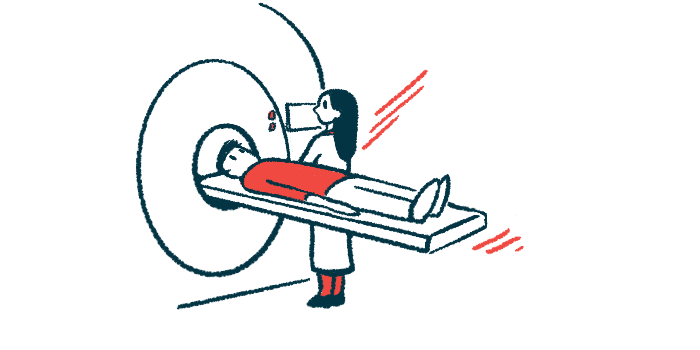Inflammatory Brain Lesions Often Don’t Match Relapse Symptoms
RRMS study delves into 'paradox' between MRI lesions and their manifestations

More than half of relapsing-remitting multiple sclerosis (RRMS) patients in a small study had active inflammatory brain lesions during a relapse, even when relapse symptoms occurred outside the brain, in areas including the spinal cord or optic nerve, researchers in Spain reported.
Less than half of the patients with brain manifestations during a relapse were found to have a lesion that could explain their symptoms.
These findings highlight “the mismatch between clinical and radiological [MRI] measures in MS,” the researchers wrote.
“Further radiological studies in larger [patient groups] are needed to better understand the [disease mechanisms] of MS relapse,” they added.
The study, “Gadolinium-enhanced brain lesions in multiple sclerosis relapse,” was published in Neurologia.
A brain MRI is a critical tool for diagnosing MS and monitoring its course over time, and is a standard method of evaluating treatment effects on disease activity in clinical trials. The presence of gadolinium-enhanced brain lesions on an MRI, which reflect areas of tissue damage with ongoing inflammation, is used to mark active disease or relapses.
Limited work into brain MRI and lesion role during a relapse
However, previous studies have shown there is a “poor correlation between MRI lesions and the clinical disease course during relapse, a phenomenon referred to as the ‘clinico-radiological paradox’,” the researchers wrote.
They identified only two studies directly evaluating the role of active brain lesions at the time of an MS relapse, and with varying results. One reported such lesions in 69% of relapsed patients, while the other detected them in 36.5% of patients and showed these lesions were linked to age and degree of disability.
The researchers, largely working in Barcelona, sought to further investigate this MS clinico-radiological paradox by analyzing the number and location of gadolinium-enhanced lesions on brain MRIs, as well as relapse symptoms, in RRMS patients experiencing a relapse.
Their analysis included data covering 90 adults (70 women and 20 men) who had participated in one of two previous Phase 4 clinical trials (NCT00753792 and NCT01986998) evaluating different routes and doses of methylprednisolone in treating MS relapses.
Patients’ mean age was 38.1, and they had been living with the disease for a median of nine years. They showed minimal disability, as reflected by a median score of two on the expanded disability status scale.
Brain MRI was conducted at the time of relapse diagnosis, within 15 days from the onset of relapse symptoms, and before methylprednisolone treatment was initiated.
Based on clinical symptoms, relapse affected the spinal cord in 42 patients (46.7%), the brainstem-cerebellum region in 28 patients (31.1%), and the optic nerves, which send visual signals from the eyes to the brain, in nine patients (10%). Relapse manifestations were classified as “other” for the remaining 11 patients (12.2%).
The brainstem-cerebellum region, in the back and lower part of the brain, is responsible for motor movement coordination and the relay of messages between the brain and spinal cord.
According to available data from 87 patients, most relapses (67.8%) were moderate in severity, 27.6% were mild, and 4.6% were severe.
Lesions here often in brain area controlling emotions, hormones
Overall, 56 people (62.2%) had at least one active brain lesion, and 66.1% of these patients had two or more lesions.
Patients with active brain lesions were significantly younger than those without such lesions (36.2 vs 41.1 years), and more lesions were found in younger patients.
These lesions were most frequently located in the subcortical region (41.4%), an area deep in the brain that’s important for functions like memory, emotion, and hormone production. Few lesions were found in the brainstem (8.8%) or in the cerebellum (5.9%).
Notably, active brain lesions were detected in 71.4% of the patients with a brainstem-cerebellum relapse, 57.1% of those with a spinal cord relapse, and 55.6% of patients with optic nerve relapse.
Results highlighted that “most relapsed patients showed several [active] lesions on brain MRI, even when the clinical manifestation was in the spinal cord or in the optic nerve,” the team wrote. Brain lesions that are not linked to active symptoms are called silent lesions.
Also, of the 39 patients with brain symptoms, 17 (43.6%) had a symptomatic brain lesion, meaning its location matched with the area affected by relapse, while 12 (30.8%) did not have a brain lesion at all.
As such, “less than 50% of patients had a symptomatic [active] lesion that could explain the symptoms of relapse,” the researchers wrote.
“These findings support the use of brain MRI in MS relapse to avoid misdiagnosis, especially in those cases in which relapse involves a therapeutic change,” they added.
Statistical analyses did not show any overall significant relationships between relapse location, relapse severity, or use of disease modifying therapies and the presence or number of gadolinium-enhanced brain lesions.
The lack of a link between the presence or number of active lesions and DMTs use may be due to the trials having taken place “between 2008 and 2015, when many of patients were not treated because of the lack of highly effective and well-tolerated treatments,” the team wrote.
Researchers noted that this analysis was also limited by the fact that spinal cord MRI was not included as part of the clinical trial protocol.
“Considering that most of our patients had spinal symptoms, the percentage of patients with symptomatic [active brain] lesions would be higher if a spinal MRI was performed,” the team wrote.
The study’s overall findings show that “most [gadolinium-enhanced] lesions are clinically silent” in RRMS patients, the researchers wrote, highlighting “the clinico-radiological paradox in MS relapse.”
Therefore, “performing a brain MRI in all patients who relapse, even in those patients with spinal cord symptoms, might increase sensitivity in detecting radiological activity and would help optimize therapeutic decisions,” they concluded.







